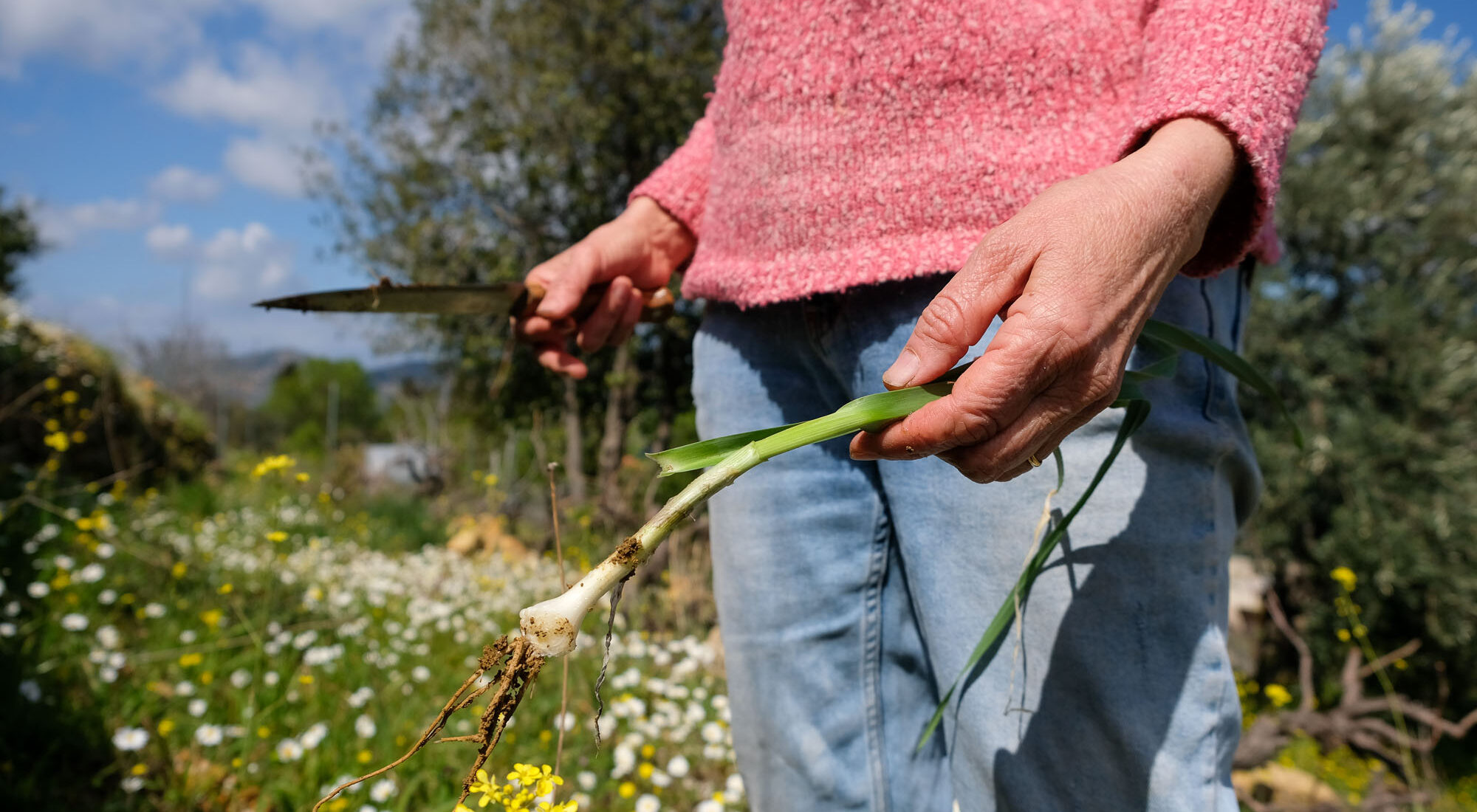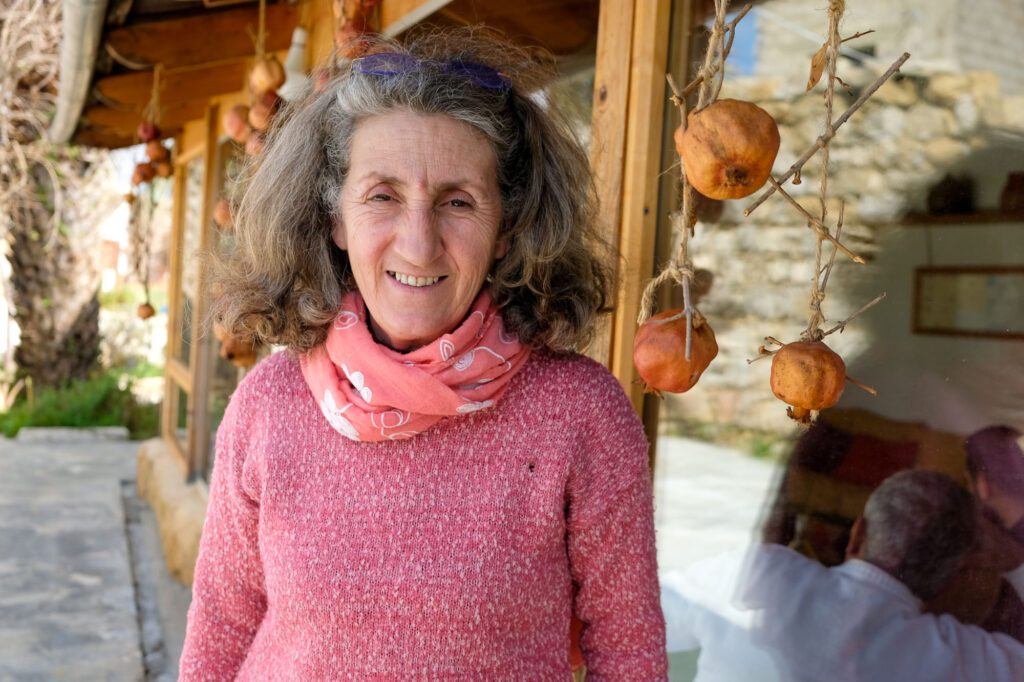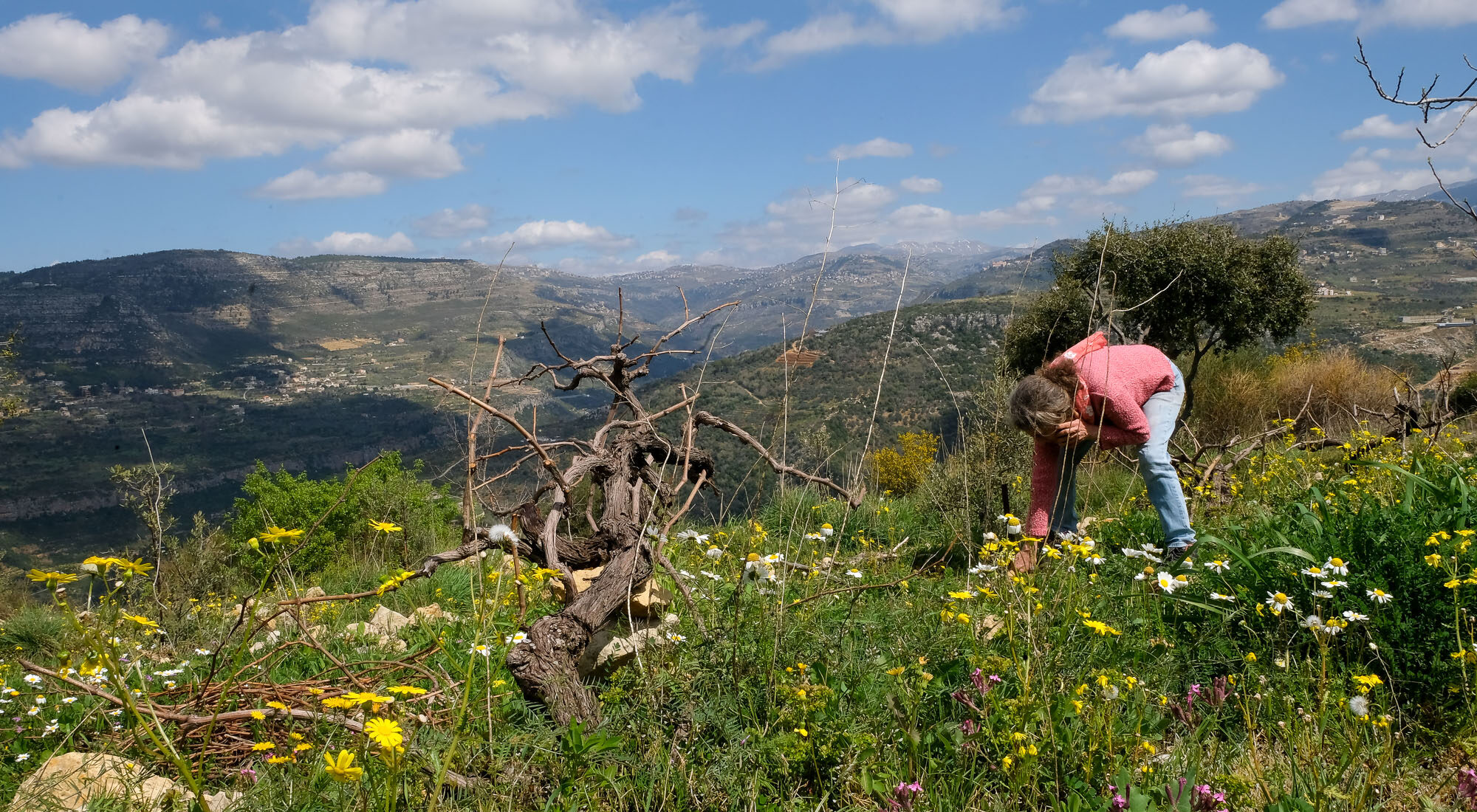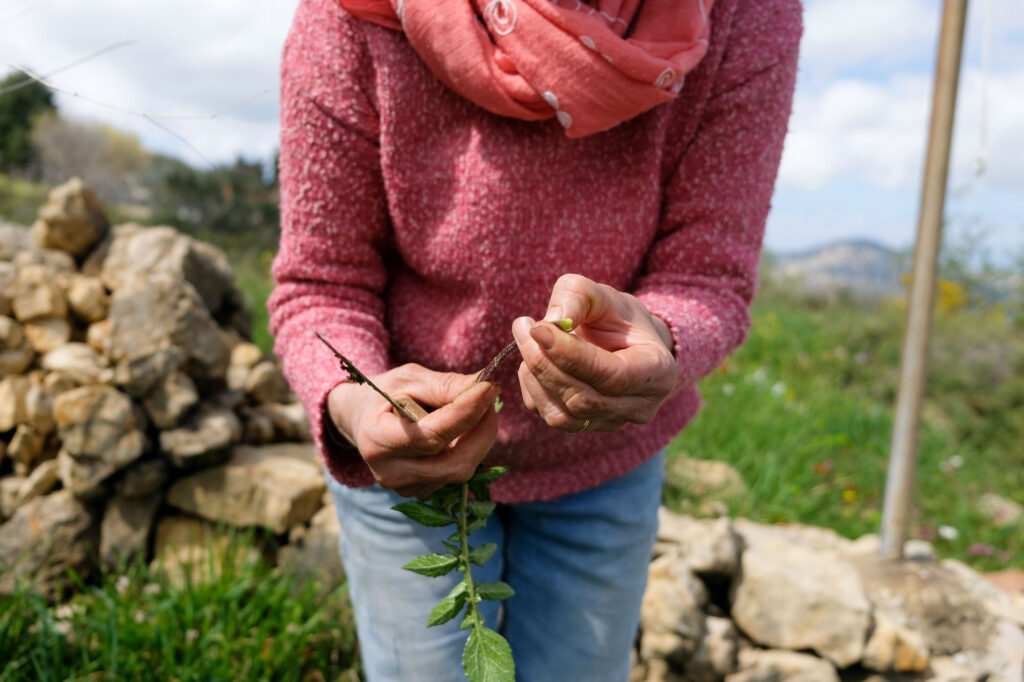WILD PLANTS IN THE CHOUF
TEXT: JENNY GUSTAFSSON
PHOTOS: JENNY GUSTAFSSON
RESEARCH: ANGELA SAADE, YARA WARD
EDITS: NISREEN KAJ
Foraging With Mayssoun Nasreddine

With a knife in hand, Mayssoun Nasreddine goes out to forage wild herbs and plants on the slopes of Kfar Qatra in the Chouf
Mayssoun Nasreddine puts her phone in the back pocket of her jeans, grabs a kitchen knife and a bag, and walks out into a grassy field on the slopes of Kfar Qatra, a village in the Chouf mountains. The view stretches across the valley below to neighboring mountains in the distance.
“This is the best thing, to go out and forage.”
Mayssoun walks at a fast pace through the grass. She knows the land well – it is a place she has come to many times. As she walks through the field, her eyes scan for wild edible plants. Foraging, or tesleeq in Arabic, is practiced by many in the mountains, valleys, and coastal areas of Lebanon, including the Chouf region.
“Look, this is dardar. We used to love this as kids,” Mayssoun says, pointing to a plant with long, coarse leaves and reddish roots. “You eat the base of the plant. It is delicious and very healthy; it holds all the nutrition of the land.”
She takes the knife and cuts the plant at its base, leaving the roots to disappear among the grass. She then puts the dardar, known as star thistle in English, in the empty bag.
The Food and Agriculture Organization (FAO) describes wild plants as “those that grow spontaneously in self-maintaining populations in natural or semi-natural ecosystems” and that “can exist independently of direct human action.” According to the same organization, around one billion peoplein the world incorporate wild foods into their diet.
Mayssoun at her home and restaurant in Kfar Qatra in the chouf mountains

Indeed, plants that grow in the wild are at the core of diets around the world. This goes back to the origins of our species: some 13,000 years ago, all humans on our planet relied on hunting and gathering wild foods. When we started to develop the knowledge of planting and harvesting, the move to agriculture was not sudden. For long periods of history, we used mixed methods of cultivation and foraging. Many popular vegetables today – like artichoke or corn – were first foraged, then domesticated (and oftentimes, in the process, modified and transformed) by humans.
Today, wild plants continue to provide additional, highly valued and appreciated elements to our diets. When mountain slopes and fields are in bloom, edible plants appear among the grass and bushes.
“We get the first qors anneh when it starts raining each year. Then, other plants follow. There’s something new every month,” Mayssoun says.
Qors anneh (eryngo in English) is a soft, thorny plant that thrives in dry soils. Its new leaves are picked and used in salads, sometimes alongside parsley in tabbouleh, or cooked with onion, garlic, and olive oil. The plant grows throughout the region, including in Palestine where it is known as “the thorn of Abraham.”
Mayssoun continues walking through the grass, bag and knife in hand. It is a sunny morning in spring, when Lebanon’s mountains come alive with greenery. With each step she takes, she keeps an eye on the ground. It does not take long before she discovers another edible plant.
“Look, this is karkamish. We cook it with chickpeas and onions. You always find it next to stones,” she remarks, leaning over to pick the small leaves of a plant barely noticeable among the grass, growing near a low stone wall that partitions the land.
Hardly has she collected the karkamish leaves before she spots another plant among the grass, with thin, elongated leaves resembling soft needles.
“This is misheh. It is best to pick the ones that grow in between other plants,” she says.
“They have long, tender leaves, unlike those exposed to the sun.”
Misheh, known as salsify or viper’s grass in English, has many health benefits. It is high in iron, fiber, and vitamin C, and has traditionally been used to treat conditions like anemia. Many foraged plants are nutritious and have a long history of medicinal use. These wild foods, sometimes referred to as “famine foods,” have played a crucial role around the world in providing high-quality protein, essential amino acids, and minerals during times of hardship.
Take dardar, for instance, the coarse plant Mayssoun liked as a child; it is high in iron and magnesium. Or Qors anneh, rich in antioxidants and used to treat allergies and asthma – and even snake bites. Other foraged plants in Lebanon have similar benefits. Khobbayzeh (mallow in English) is a plant with big umbrella-like leaves and known for its anti-inflammatory properties. Farfahine, or green purslane, is believed to lower cholesterol, as well as treat constipation and stomach ache.
Many studies support folk beliefs in the medicinal properties of wild plants. For example, the Asteraceae family, which includes plants like artichoke and chicory, has been proven to possess anti-inflammatory and wound-healing properties. This is the most foraged plant family in Lebanon. Studies of early farmers in Europe and wild herbs in Turkey also found foraged plants to be nutrient rich.

“We always used to live and eat like this. I used to wonder why we didn’t get sick,” Mayssoun says.
After having children, Mayssoun and her husband Walid began to follow a vegan diet. It was for health reasons, she explains, and focused on natural and organic foods.
“I used to have a lot of headaches and cured myself with this food. When Walid saw that I was getting better and the kids were doing well, he was also convinced,” she says.
In 2002, they started Coara, a food business that has now grown into a production line and restaurant on one of the slopes in Kfar Qatra. They grow some of the vegetables used in the kitchen on a land next to the restaurant, source the rest from nearby farmers, and they forage.
“I learned this from my mom. She taught me things, like how to differentiate between plants. My dad didn’t forage a lot,” Mayssoun says.
This pattern is seen worldwide, where foraging is mostly carried out by women. Knowledge gets passed down through generations, including plant identification, preparation, and understanding of the local ecological context. Interestingly, women often have higher levels of food-related knowledge. A study conducted in Nepal, for example, showed that women over 35 years of age could describe 65 percent of all edible species, while young men only knew 23 percent. In Lebanon, women often provide a link between rural lands and urban dwellers; it is common for people, often women, to sell a variety of wild plants on the sidewalks and busy corners of cities.

Wild cyclamen, used instead of vine leaves to make a wild variant of stuffed dolma
Under the blue sky in the Chouf, Mayssoun suddenly stops to pick another plant growing among the grass. This time, she cuts the leaves of a plant that, at first glance, looks almost exactly like the surrounding weeds.
“No, it’s not the same. See, the leaves are a bit different. They are more rounded and have this white part at the base. The taste is very nice, similar to garlic,” she explains.
She takes the plant, qorrat or wild leek in English, and drops it into her bag. There is also wild-growing hindbeh (chicory), a popular variety from the Asteraceae family that is cultivated and served in Lebanese homes and restaurants. It is cooked with olive oil and lemon, and topped with fried onions – the mild fat, tangy citrus, and sweet caramelized onions balance the bitterness of the leaves.
Lebanon, located on the far eastern shores of the Mediterranean, is abundant with plant species. The entire Mediterranean region is home to 25,000-30,000 species (around one tenth of them in Lebanon), out of which some four percent are edible. But only 150-200 varieties are currently consumed.
In 2007, a study in Lebanon compiled a list of common recipes using wild plants. It included dishes like khobbayzeh with labneh, qors anneh with tahini, and fatayer dumplings with zaatar (wild thyme). There is also akkoub (gundelia in English), a beautiful spiky plant that appears on high altitudes during spring and tastes similar to artichoke. Some researchers even speculate that the thorny crown of Jesus might have been woven with akkoub spikes.
“The land is so rich, it has so much to give to us,” Mayssoun says.
Globally, it is believed that over 7,000 species have been used for human consumption at some point in history. However, we eat a limited number of varieties today, with around 90-100 species commonly consumed in each region.
But there are some areas or groups of people that have more diversity. There are communities in parts of India, Ethiopia, and Kenya, for example, that eat as many as 300 – and up to 800 – species from nature.
Close to Lebanon, Kurdistan has a rich tradition of putting raw foraged herbs on the table – akkoub is eaten in Kurdistan, as are plants like mint, watercress, sorrel, and wild mustard.
Attaching the word “wild” to the name of a plant, however, might lead us astray. The notion of a clear separation between wild and cultivated, as if they belong to separate worlds, is misleading because humans and nature are in constant interaction. The Slow Food movement prefers to talk about “uncultivated” or “historical” food instead, as the word “wild” might turn people away, thinking that such foods are unsafe or uncontrolled.
For a long time, the image of foraging has been associated with a sense of pity or shame, as something done out of necessity by marginalized communities. This perpetuates colonial ideas about so-called “natural” versus “civilized” people, where the former is seen as less developed. A landmark book, “Man the Hunter” from 1968, debunked such ideas about hunter-gatherer people, highlighting instead how these communities were rich, knowledgeable, and advanced in their techniques.


Mayssoun finds different edible herbs and plants with almost each step she takes

Our gradual removal from wild foods over the course of many centuries has led us to grow more and more distant from nature. It has also made us less connected to the food we eat, and to locally rooted culinary traditions and customs. Foraging is a way to rekindle that bond.
Interestingly, in recent years, there has been a significant shift in the perception of wild harvesting. The New Nordic movement in cooking, with Danish restaurant Noma at the forefront, managed to transform foraging into something intriguing and hip. René Redzepi, the founder of Noma, used to have at least five foraged foods on his menu at any given time. At one point, in the early 2010s, so many articles were written about this trend that it was wittily dubbed “The Era of the ‘I Foraged With René Redzepi Piece’.”
For Mayssoun and Walid, including foraged dishes on the menu is an integral part of their culinary heritage. Fadi Kattan, a chef from nearby Palestine, serves similar dishes. His London restaurant – which is named Akub – offers things like khobbayzeh, hindbeh, and hwairneh (wild mustard).
“We eat a lot of these wild herbs in our daily food. People ask me how I manage to find all these things, but I just love nature and being in the wild,” Mayssoun says.
As she continues walking through the grass, just off the main road leading through Kfar Qatra, she points to a fence that has been put up, closing off parts of the land. It was not like this when she was young, she says. Back then, they could collect plants and herbs from the entire area.

Access to wild foods is declining in many parts of the world. Industrial expansion, urban sprawl, and large-scale agriculture are encroaching on wild or common lands. And the globalized and streamlined food production of today is causing people, especially indigenous and rural populations, to lose access and ownership to land. In Lebanon, in a study that looked at these issues, people named factors like urbanization, land degradation, and privatization as threats to foraging.
“There was a decline in foraging as people wanted a more urban lifestyle and moved to the cities. It also led to a preference for ready-made things, as it is much easier. But they have started to see how this affects their health,” Mayssoun remarks.
The bag in her hand is starting to get full – besides the qors anneh, hindbeh, misheh, dardar, and qorrat she found, there’s also doueik el jabal (thick green cyclamen leaves used as an alternative to vine leaves) and zawaiti (a dark green plant used in salads).
Mayssoun and Walid at their restaurant Coara in Kfar Qatra, where they serve food made using their own and other local produce

“I should have brought another bag. I won’t pick everything I see today or else we’ll be here for three more hours,” Mayssoun says.
She retraces her steps back towards the main road, walking with the green mountains of central Lebanon behind her. At one point, she stops as she discovers more wild hindbeh growing at her feet.
Among all the leafy greens in the country, hindbeh is one of the most commonly eaten, and is now cultivated in large quantities by mainstream growers. Fortunately, Mayssoun says, not all wild plants face this fate.
“Let’s leave some things to nature. It’s fine if we get some things from God and our surroundings. Let us not control everything.”

